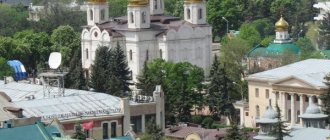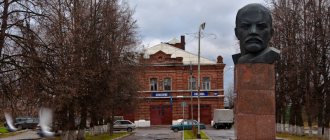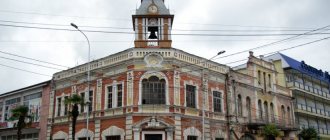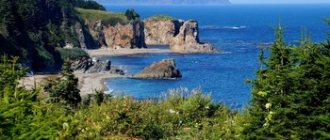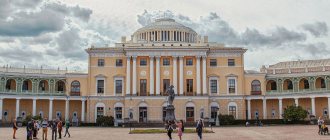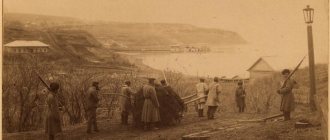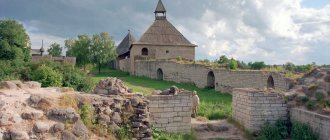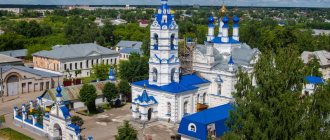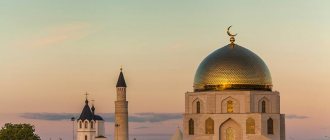Sights of Konakovo. Historical reference. The administrative center of Konakovo is located in the Tver region, on the banks of the Ivankovo reservoir, on the Volga River.
The distance from Tver is 82 km. In 1809, pharmacist Friedrich Christian Brynner founded a faience factory in the village of Domkino. Then the factory was moved to the village of Kuznetsovo.
The highly artistic and high-quality faience produced at the factory quickly gained fame. In place of the village, a settlement began to grow quickly. In 1870, the factory was bought by merchant Matvey Sidorovich Kuznetsov. The coincidence between the new owner of the factory and the name of the village is surprising. Under him, a sharp rise in production began. Unfortunately, in 1929, Kuznetsovo was renamed Konakovo, in memory of the revolutionary Porfiry Petrovich Konakov. Currently, about 39 thousand people live in the city.
Sights of Konakovo
- Earthenware factory
Located on the street of energy workers. It was the earthenware factory that made the village of Kuznetsovo famous. At the end of the 19th century, the plant's products reached an international level. The plant won medals at the World Exhibition in Paris and Chicago. The owner of the plant, Kuznetsov, was awarded the Order of the Legion of Honor by the French government.
The war years were very difficult for the plant, but it survived. In 1958, some of the plant's works were awarded a gold medal at the World Exhibition in Brussels. International cooperation with many countries of the world has successfully developed. Alas, the end of the plant was sad - in 2013 it was declared bankrupt. Thus ended the glorious history of the plant, which would now be over 200 years old!
Currently, the factory area is completely abandoned. On it you can see the ancient buildings of the plant, which are classified as monuments of industrial architecture.
- Estate of the Rozhdestvensky merchants
Only this brick building survived from the city of Korcheva. The district town of Korchev was located twenty kilometers from Konakovo. During the construction of the Ivankovo reservoir in 1937, the city was completely flooded. In those days, many wooden buildings were transported from Korchev to Konakovo. The Rozhdestvensky estate was able to survive this flooding. Tourists love to visit this house.
- House of Prince Gagarin
This estate was acquired by Grigory Grigorievich Gagarin in 1847. He built a magnificent building in the Italian style.
The village of Karacharovo, where the estate is located, belonged to the Tatar brothers Karachar in the 15th century. G.G. Gagarin was an outstanding and enlightened figure of his time, an artist and poet.
Gagarin studied the art of painting from the famous artist Karl Bryullov.
Many of Gagarin’s works are in the Tretyakov Gallery, the A.S. Museum. Pushkin, the Russian Museum and the Tver Regional Art Gallery.
Isn't this recognition of the artist's merits? He created more than 2 thousand paintings, drawings and watercolors.
G. Gagarin was close to Lermontov and Pushkin. He made many illustrations for Pushkin's works. During Gagarin's lifetime, a magnificent park with 54 alleys was created. Today only 8 have survived, but it takes a lot of work to put them in order. The house has been well preserved and now houses a health resort for rich people - the Karacharovo holiday home. Some service buildings have also been preserved.
G. Gagarin died in France, but was reburied in Karacharovo, according to his will. The prince's grave is also located on the estate, and a memorial plaque in honor of his memory hangs on the building.
Also on the territory of the estate is the patronal church of Peter and Paul. It was also built by Prince Grigory Gagarin. For these purposes, he gave part of his estate for the church.
- Museum of Local Lore
Located on Lenin Avenue. It was opened in Konakovo in 1990. The exposition of the Konakovo Museum tells about everything connected with these places - the history of the region, local traditions, famous people, natural features, minerals, archaeological finds and so on. In the bronze period hall there are many archaeological finds, and in the hall dedicated to G. Gagarin there are a large number of various documentary sources.
- Church of the Nativity of the Virgin Mary
This ancient church is located in the village of Gorodnya, not far from Konakovo.
It was built in the 14th century. Throughout its long history, the temple was subject to fires and devastation from enemy raids and therefore was rebuilt more than once.
So in the seventeenth century the temple suffered from a fire and was restored with the money of the landowner P.A. Bema.
In 1745, the temple was newly restored and painted. A brick refectory and a hipped bell tower were added to the temple. Another fire occurred in 1801. At the end of the 19th century, the interior of the temple was painted with oil paintings.
Severe damage to the temple was caused during the Great Patriotic War. Until the 1980s, restoration was carried out there. The 15th century frescoes were restored. There is no escape from hard times, but the main thing is that the temple was restored all the time.
- Konakovskaya GRES
Its construction began in 1962 and was completely completed in 1969.
Initially, the power plant operated on fuel oil, and in 1989 it was switched to natural gas. This is one of the largest state district power plants in Central Russia. Its annual capacity is 2520 MW.
Note. Of great interest are the Shumnovsky lakes, located in the Konakovsky district, as well as the Konakovsky Bor nature reserve.
- Temple complex of the Assumption of the Blessed Virgin Mary
This beautiful architectural ensemble is located in the village of Zavidovo, Konakovo district. The temple complex includes the winter Assumption Church with three altars, the summer Trinity Single-Altar Church, a 5-tier bell tower, a Sunday school, the Museum of the History of the Village of Zavidovo and the Museum of Folk Crafts of Russia.
The Assumption Church is the oldest - they are mentioned in the district scribe book of 1623. It has been well preserved to this day. During the reconstruction of 1820, the church was covered with iron, and in 1853 the old refectory and bell tower were dismantled. In their place they erected a large structure and a 3-tier brick bell tower. The authorities closed the church in the 1930s, but in the 1950s they returned it to believers. Until now, its gradual restoration is underway.
The Church of the Holy Trinity, also located in Zavidovo, was erected in 1787. It is a stone, five-domed, single-altar temple.
During the Soviet years it was closed, and there was a toy factory there. In 2004, it was restored and returned to believers.
- Sturgeon hatchery
The plant is located at the Konakovo State District Power Plant. Endangered valuable fish species - beluga, sturgeon and sterlet - are raised there.
Thanks to this plant, new technologies for growing juvenile Siberian sturgeon in warm-water farms were created. The plant is located on Promyshlennaya Street.
Konakovsky municipal district of Tver region -
| Lee Maxim Efimovich | Acting Head of the City of Konakovo | 171252, Tver region, Konakovo, st. Energetikov, 31A Tel./Fax: +7 (48242) 3-70-14 |
Official website of the Konakovo city administration
Brief information
The city of Konakovo was founded in 1937 and is located on the right bank of the river. Volga, 130 km north-west of Moscow, close to the highway and railway Moscow - St. Petersburg.
Permanent population as of January 1, 2009: 40.7 thousand people, including:
— below working age – 7.0 thousand people; — working age – 24.1 thousand people; — over working age – 9.6 thousand people.
Area – 3907 hectares.
Industry today is represented by large and medium-sized enterprises: - OJSC Konakovskaya GRES - a subsidiary joint stock company of OJSC OGK-5 (electricity generation, heat supply). — OJSC “Energostalkonstruktsiya” (steel building structures). — Konakovo industrial and construction branch of JSC SPK Mosenergostroy (precast reinforced concrete). — Bakery plant – phil. OJSC "Tverkhlebprom" (bread and bakery products, confectionery). — LLC (equipment production) — SE Printing house (printing products)
The city's construction industry is represented by 3 large and medium-sized organizations: OJSC PMK-376, CJSC Energostroy, OJSC Remstroy OGK-5.
Forestry – State Enterprise “Konakovsky Forestry”, Municipal Municipality “Konakovsky Bor”
Transport and communications - State Unitary Enterprise "Konakovskoe DRSU", OJSC "ATP Konakovskaya GRES", OJSC "Konakovskoe ATP", Konakovsky post office of the Federal Post Office of the Tver Region - a branch of the Federal State Unitary Enterprise "Russian Post".
Banking system Konakovo branch of Sberbank of the Russian Federation, Tveruniversalbank branch, additional office of the Rosselkhozbank branch in Konakovo and Konakovo branch of the Yaroslavl branch of Bank of Moscow OJSC.
Insurance, OJSC GSK Skif-Tver, branch of LLC RGS-Center, Konakovo branch of CJSC SAC Informstroy, LLC NBSC Konakovo, . There are more than 200 small businesses in the city and about 1.1 thousand individuals are engaged in entrepreneurial activities.
Education scheme: 10 educational schools, including one evening school, with 4,587 students, 10 kindergartens - 1,630 children. The city has PU - 52, two colleges, the Konakovo branch of the Russian International Academy of Tourism, a branch of the Moscow Psychological and Social Institute, a branch of the Tver State Technical University, a branch of the Eurasian Open Institute. Culture – two cultural and leisure institutions (GDK named after “Vorovsky” and DK “Sovremennik”). The tourist attractiveness of the city is developing: the Karacharovo SOC, the Energetik boarding house, and the Konakovo Hotel invite city guests. The municipal formation of the urban settlement of the city of Konakovo includes the following settlements: the city of Konakovo, the village of Karacharovo, the village of Belavino, the village of Energetik, the village of Shumnovo, the village of Rechitsy, the village of Vakhromeevo.
The city of Konakovo has its own coat of arms and flag
Official website of the Konakovo city administration
Additional information can be obtained in the section Heads of settlements and Heads of administrations of settlements
Religion
An Orthodox church was opened in Kuznetsovo in 1891, built at the expense of the factory owner. The temple was destroyed under Soviet rule. After the destruction of the Alexander Nevsky Temple in 1961, there was no large church in the city. At the beginning of the 21st century, Konakovo was the center of the Konakovo deanery of the Tver diocese, construction of a large-scale temple of the Forty Martyrs of Sebaste was underway.
In 1915, an Old Believer church was opened, for which two faience and enamel iconostases were specially made. It was destroyed under Soviet rule.
Temples of the city
- Alexander Nevsky (dismantled in 1961)
- Arseny Selikhovsky, chapel
- Mikhail Tverskoy and Anna Kashinskaya
- Forty Martyrs of Sebaste (under construction)
- Healers, icons of the Mother of God, at the Central Regional Hospital
Temples of the Deanery
- Exaltation of the Holy Cross in the village of Sverdlovo
- Ascension of the Lord in the village of Teshilova
- St. George the Victorious in the village of Yuryevo-Devichye
- Demetrius of Solunsky in the village of Staroe Melkovo
- Elijah the Prophet in the village of Selikhov
- Mary Magdalene in the village of Redkino
- Nikita the martyr in the village of Shosha
- Peter and Paul in the village of Karacharovo
- Nativity of John the Baptist in the village of Kozlov
- Nativity of the Blessed Virgin Mary in the village of Gorodnya-on-Volga
- Sergius of Radonezh in the village of Dmitrova Gora
- Smolensk Icon of the Mother of God in the village of Teshilovo
- Church of the Savior Not Made by Hands in the village of Dulovo
- Spiridon of Trimifuntsky in the village of Bolshie Peremerki
- Trinity of the Life-Giving in the village of Zavidovo
- Dormition of the Blessed Virgin Mary in the village of Fedorovskoye
- Dormition of the Blessed Virgin Mary in the village of Zavidovo
Konakovo local historians about the history of the name of our city
According to local historians, the city is named not in honor of Porfiry Konakov, but in honor of the entire Konakov family, whose descendants remain to live in the city and continue to contribute to the development of our small homeland.
02 April 2022, Thursday 17:00 | Author: Irina Tretyakova Correspondent
Not long ago, an interregional scientific and practical local history conference was held at the Konakovo Museum of Local Lore, dedicated to the 90th anniversary of the formation of the Konakovo district, at which the head of the theoretical department of the Autonomous Educational Institution "Children's Art School" of the city made a report "Study of the role of the Konakov family in choosing the name of our city" Konakovo, local historian Lyudmila Gennadievna Efremova. We invite our readers to familiarize themselves with unique historical material.
In 2022, it will be 90 years since the formation of the Konakovsky district. At the same time, another event occurred: in 1930, the Central Executive Committee of the USSR decided to “rename the working village of Kuznetsovo and the Kuznetsovsky district of the Kimry district of the Moscow region: the first - to the working village of Konakov, and the second - to the district of Konakovsky.”
Before getting acquainted with the history of the renaming, let’s find out the etymology of the word that underlies the name of our city. In the dictionary V.I. Dahl we read “Konak m. - friend, buddy, comrade, with whom you take bread and salt.” The name "Konakovo" is unique. There is no other settlement with this name on the world map.
Having traced the dynamics of the development of the economy of our city in the 20s-30s of the 20th century, it becomes clear that from the moment the village was given the name Konakov, its rapid development began. The earthenware factory restores the pre-revolutionary level of production and receives the highest award at an exhibition in Paris in 1937, a railway line comes from Reshetnikovo to Konakovo, 4 thousand residents move from the flood zone of the Ivankovo reservoir along with their houses, new streets appear and in 1937 the village becomes city. Thus, the meaning and energy of Konakov’s words had a beneficial effect. The renaming can be considered successful.
This is how Maria Vikulovna Ilyutina recalls the events of the end of 1929 on the page of the Zarya newspaper No. 44 dated December 13, 1958. “I babysat Maria Mikhailovna Osetrova, now she is the head of the school, she lives on Svoboda Street. My brother Mikhail Vikulovich Parnyakov also lived in the same house. I babysat his daughter Manya. Workers often came to see my brother, two or three at a time, and talked quietly for a long time behind the partition. One day, one of those gathered said: “Konakov is coming!” – The door opened and a short young man in a dark hat came in. The conversation went on behind the partition for a long time. Out of curiosity, I listened, but only isolated words reached me, and I could not understand the meaning of their conversation.
The second time I heard about Konakovo was in Riga. There I worked at a porcelain factory. On some day, I don’t remember exactly, but it was before 1905, a whisper went through the painting workshop: “Get ready for the forest today, Konakov has arrived!”... Then Maria Vikulovna fell silent. Her story was continued by her husband Mikhail Yakovlevich: “I remember how Porfiry Petrovich Konakov lived with us in Kuznetsovo in May-June 1906. I was working in a painting studio at the time; there was a smoking room nearby. Workers were strictly forbidden to smoke in the workshop and for this purpose they gathered in the smoking room. P.P. came here to see them. Konakov conducted propaganda. He talked about capitalists and how they get rich from the sweat and blood of workers.
Maria Vikulovna intercepted the thread of memories: “In 1906 he was shot in St. Petersburg. And for some reason I remember him very much. After the revolution, everyone in Kuznetsovo was managed by the village. In 1929, Mazov, the chairman of the village, announced a competition to rename the village. The workers hated the name Kuznetsovo, as it constantly reminded of the former owner of the factory. The workers offered different names in return. Among them were “Volgo-Don”, “Stenka Razin”, “Proletary”, “Hammer and Sickle” and many others. And I thought, why don’t we name the village after P.P. Konakov, our worker who died for the cause of the revolution. I wrote my proposal and submitted it to the village. Soon a decree was issued, and the village was named after the revolutionary worker Konakov.” (author of the interview, correspondent of the Zarya newspaper P. Shvachinsky).
Now let’s get acquainted with the role of the Konakov family in the history of our city.
At the beginning of the 19th century, capitalist relations were formed in Russia. In 1801, free purchase and sale of uninhabited land was allowed. In 1803, landowners received the right to free peasants for ransom. In 1818, peasants were allowed to open industrial enterprises. Farming here has always been a risky business. Early cold snaps and crop failures forced landowners to let peasants go on quitrent. The most enterprising peasants quickly earned initial capital, opened forges, sawmills, and hired workers.
In this way, two classes of the future capitalist society are formed: the bourgeoisie and the working class. (Proletarian – in V.I. Dahl’s dictionary – a homeless person, a homeless person or a landless person). This definition is in no way suitable for that part of the Russian working class, which was formed from Old Believers. This group of the population had large families and their own houses. They possessed high professional skill in their craft.
In the history of our city, this is clearly seen in the example of two families of Old Believers - Matvey Sidorovich Kuznetsov and Pyotr Ivanovich Konakov - the father of Porfiry Petrovich Konakov, whose name our city bears. In Russia, serfs did not have surnames. When peasants redeemed themselves or went on quitrent, they were given surnames by patronymic (Ivanov, Petrov), by occupation (Kuznetsov, Rybakov), or by nickname, the meaning of which corresponded to the character of the person. The Konakov family lived up to the meaning of their surname.
“The Old Believers, cut off from society in the second half of the 17th century, went through a difficult path from exile, loss of social status, and sometimes even life, to acquiring unprecedented inner strength, which allowed them to take the lead in the processes of modernization of production in Russia in the second half of the 19th century, at the core which lay FAITH as the main value, hard work and a high level of discipline. Old Believers, especially the generation of M.S. Kuznetsova in their individual lives repeated the historical path of the entire Old Believer society.”
The Kuznetsov family lived in Novo-Kharitonovo, Bogorodsky district, Moscow province, where in 1810 Yakov Vasilyevich Kuznetsov, a Gzhel peasant by class, and by profession an artisan - blacksmith and timber merchant, founded his first porcelain factory. Then the same factories opened in Dulevo and Riga.
In 1970, great-grandson Matvey Sidorovich Kuznetsov bought a famous faience factory in Russia from Auerbach in the village of Kuznetsovo in Tver Province. At this time, the factory was in complete decline: 86 people worked at the plant, products were produced in the amount of 21,600 rubles, and just over 200 people lived in the village, almost all the houses were empty.
Matvey Sidorovich Kuznetsov invites peasants from the surrounding villages to work - carpenters, joiners, blacksmiths - and begins to build private and apartment buildings (the so-called soils). One of them has survived to this day - this is house number 42 on Svoboda Street, next to the Svetlana store "), school, hospital buildings. (Among those who arrived was my great-great-grandfather Grigory Lubov, as evidenced by the autobiography of his son Gavrila. Together with other workers, they created a carpentry artel, which fulfilled factory orders, built bridges, and the Vorovsky Palace of Culture. (The artel’s activities lasted almost 70 years.)
As housing was put into operation, porcelain and earthenware production specialists gradually moved from the Gzhel region. From time immemorial, Gzhel has been famous for its craftsmen of various professions. They skillfully painted church books, dishes, worked on wood, and made jewelry.
M.S. Kuznetsov gives work to thousands of his fellow believers, because they were good specialists in their field, they knew how to organize and control production, thanks to their organization and discipline. Kuznetsov transports entire families of Old Believers to new factories. They become the support of management in improving porcelain and earthenware production.
This happened in the village of Kuznetsovo. By the end of the 70s of the 19th century, 300 families of Old Believers from Guslitsy and Gzhel moved here. (The number of workers in 1879 was 861 people, and products were produced for 400 thousand rubles, that is, the number of workers and product output increased 20 times).
Among the settlers was the family of the painter and, later, master of chandelier (pearl glaze) production, Old Believer Pyotr Ivanovich Konakov. His second profession led to an accident: he was badly burned while draining the finished glaze. Then he spent a whole year being treated for a burn in a local hospital at the expense of the factory owner. Paramedic Voronov was able to put him back on his feet and he returned to his previous place of work. It is quite possible that Pyotr Ivanovich completed his treatment in Essentuki, where the Kuznetsov Partnership maintained a sanatorium building for its employees.
Kuznetsov valued workers with rare specialties.
In the family of Pyotr Ivanovich and Agrafena Andreevna Konakov there were 6 children: 5 daughters and a son, Porfiry, who was born no earlier than mid-August and no later than the beginning of November 1878 in the village of Antsiferovo, Bogorodsky district, Moscow province. (Now the Noginsk district of the Moscow region).
Porfiry spent his childhood in the village of Kuznetsovo. He graduated from the 4th grade of a factory school. Here his curiosity, lively mind and extraordinary abilities in mastering knowledge were revealed.
In 1890, the 4-year course of study ended and 12-year-old Porfiry became a student of a rare master - the painter Sergei Vasilyevich Krasnoshchekov, his father’s workmate.
During his studies, Konakov mastered the intricacies of painting, carefully followed the techniques of work, and learned the professional secrets of a skilled master.
Porfiry has a lively disposition, a restless character, and an inquisitive mind. Most of all, he could not tolerate injustice. I read a lot about distant countries, about travel, and I wanted to become a traveler myself. When he turned 15, he received the right to work independently.
Porfiry matured beyond his years. You couldn’t call him handsome: his face was covered with freckles, his hair had a reddish tint, he was stocky, thick-set, like his father. He was fair and honest. He didn’t offend anyone himself, but he didn’t let the offender off the hook either. Didn't drink, didn't smoke. The girls from the settlements were offended that Porfiry avoided them. And the guys, although they laughed, respected him.
The superintendent and the masters did not like the directness of judgment, fairness and free-thinking statements. Porfiry began to be oppressed: he was given unprofitable jobs, fined, and, in the end, forced to leave the factory. This happened in 1895. Porfiry turned 17 years old.
How to live further? For a long time now, his friends had been calling him to Riga, to the porcelain and earthenware factory of the same M. S. Kuznetsov Partnership. They wrote that the workers there were friendly, the craftsmen did not dare to be willful, the wages were much larger and higher than in Kuznetsovo.
And now, Porfiry Konakov is in Riga. It was easy to get a job; good craftsmen were needed there. He decided to live as a “freeloader” for a warehouse worker for finished goods, who had his own house. And 6 young people lived with him. Koankov picked up like-minded people, since he was the first to settle here. Friends gave their word to stand for each other and keep their mouths shut. And there was a reason.
Here in Riga, Porfiry did not change his views. He continued to speak out against the oppression of his employers, and his free-thinking speeches were heard by social democratic-minded workers. They began to involve me in underground work. This is how Porfiry established connections with workers’ organizations in Riga.
Porfiry himself read all the underground literature he came across and shared what he read with the workers. Since his school years, he had been an excellent storyteller, and this talent came in handy now when he became a militant agitator for a revolutionary organization.
All this could not go unnoticed. The factory administration and the police began to take a closer look at his affairs. So Konakov comes under the secret surveillance of the police.
At the end of January 1902, after the caretaker found him among other workers reading the newspaper Iskra and wrote a denunciation to the police, the Livonia provincial gendarmerie department began an investigation. However, Konakov persuaded his friends how to behave during interrogations. And the naivety with which Porfiry and his friends told the investigation about what had happened “convinced” the gendarmes that they were accidentally involved in the story with the newspapers.
Already at that time, Konakov was a good conspirator, and the gendarmes did not even suspect him of participating in large underground activities. And he, under the party nickname “Egorka,” at that time carried out painstaking and persistent work to create an underground trade union of workers and employees of industrial enterprises in Riga. The tasks of the trade union included: protecting the rights of workers before the owners, providing assistance to workers in case of illness and dismissal from work, as well as providing for the families of workers arrested for revolutionary and trade union activities.
In 1903 and 1904, the name Konakov again appears in the affairs of the police department. The bailiff’s report in 1904 stated “... according to secret observation, workers of the Kuznetsov factory Porfiry Petrov Konakov and Alexander Vsevolodov (Vishnyakov) aka Vsevolodov, living on Vologodskaya Street No. 1, by their lifestyle and the circle of their acquaintances, give reason to assume that they are politically unreliable. Being in close friendship with students of the Riga Polytechnic Institute Pavel Maksimov Yaroslavtsev and Alexander Pavlov Uralov..., they arrange secret meetings among themselves in Konakov’s apartment. According to secret surveillance, one was noticed on January 24 at 9:45 in the evening, in which Konakov, three unknown people and student P. M. Yaroslavtsev participated, and the latter made a speech of a revolutionary nature.”
This meeting was reported to the prosecutor of the Riga court, and the head of the Livland gendarmerie department, and the detective department.
At the beginning of 1905, when revolutionary events began to brew, the gendarmerie staged a provocation against Konakov: a robbery of the cashier of a porcelain and earthenware factory was staged. Five masked men attacked him, took his money, took three thousand rubles worth of gold, threw away the banknotes and disappeared.
Konakov was immediately accused of “expropriation”. He was immediately arrested. The investigation was carried out for a long time, and although there was and could not be reliable evidence of Konakov’s participation, he was kept in custody. It was important for the gendarmes to remove Konakov from Riga, where the mood of the workers was becoming more and more revolutionary. Moreover, messages about Bloody Sunday in St. Petersburg reached here, and Riga residents began to prepare for a general strike.
Taking advantage of the rights of a state of emergency in connection with the unrest in the city, the gendarmerie department keeps him in prison, and then sends Porfiry Konakov in a convoy to his homeland in the village of Kuznetsovo under the open supervision of the police and the responsibility of his parents.
On January 12, a strike began in Riga. In February–March, new strikes took place, including at the Kuznetsov porcelain and earthenware factory.
But Konakov could not participate in these events: at that time he was in a transit prison and only fragmentary information about the revolutionary actions of the Russian proletariat reached him.
Only in the spring of 1906, Konakov’s mother received a notification from the district town of Korcheva: “I hereby inform you that your son Porfiry Petrovich Konakov, released from prison, is on his way to the city of Korcheva.”
Konakov spent the entire May 1906 in Kuznetsovo. Here he contacted local Social Democrats and assisted in the work of an underground Social Democratic circle, with which one of Konakov’s sisters was associated.
In June, he often traveled to Moscow and Yaroslavl, carrying books and proclamations. And in July I got ready to leave completely. Together they collected fifteen rubles, and Porfiry left for St. Petersburg, where revolutionary events were brewing in the fleet.
Thus began the last chapter of the life of the professional revolutionary Porfiry Petrovich Konakov.
In the summer of 1906, the first Russian revolution was still ongoing. An uprising was brewing in the Baltic Fleet. By that time, the personnel of the fleet and naval base had been replenished with mobilized revolutionary-minded workers, as well as sailors who had taken part in the unrest in Libau and Sevastopol and on the ships of the Caspian Flotilla who had been transferred here. But the uprising did not have an ideological basis or organizational basis, and therefore was doomed to failure. The Social Democrats understood this and tried to keep the sailors from making an untimely speech.
But when it became clear that it was impossible to prevent the uprising, it was decided to be with the people, organize the rebels, stand at their head and lead them into a decisive battle against tsarism.
Member of the Central Committee Dmitry Zakharovich Manuilsky and representative of the Petersburg Committee Joseph Fedorovich Dubrovinsky arrived in Kronstadt at the direction of the St. Petersburg Committee of the RSDLP. They established connections with RSDLP organizations and revolutionary committees in military units, on forts and on ships.
On July 17, 1906, an uprising began in the Sveaborg Fortress. On the morning of July 19, the organizers of the military demonstrations arrived in Kronstadt in different ways, among them: professional revolutionary Porfiry Konakov, student Aram Ter-Mkrtchan and St. Petersburg worker Konstantin Ivanov.
However, the uprising was not a surprise to the command of the fortress. Through provocateurs and spies, the authorities became aware of the preparations and time of the start of the uprising. Military units loyal to the government were brought to Kronstadt in advance, and leading groups of sailors on almost all ships were arrested.
On July 19 at 11 pm the uprising began in Kronstadt.
The first stage of the uprising was successful. Konakov raised the red banner over the revolutionary fort "Constantine". Those who saw Konakov at this time said about him: “A young Social Democrat, energetic, ardent, a complete bundle of nerves.” He knew how to charge others with his enthusiasm.
However, due to unreliable communications with other forts and ships, there was no signal about the start of the uprising - 4 artillery shots. The rebels failed to capture artillery ammunition depots. In Kronstadt, the units ready for the uprising were waiting for the signal and did not know about the success of the rebels at Constantinople and Litka. And at 2 a.m. on July 20, selected units of the St. Petersburg garrison were thrown at the rebel forts. The artillerymen from the “Constantine” who did not go over to the side of the rebels raised a white flag, freed the officers, and arrests of miners and other rebels began. At five o'clock in the morning on July 20, the uprising was suppressed.
At noon on July 20, the military court began working. Witness testimony proved the direct involvement of Konakov and other envoys of the St. Petersburg organization of the RSDLP in organizing the uprising.
The indictment states: “Witnesses certified that Konakov was at Fort Constantine with a red flag and was in charge of the rebels.”
In order to hide the political essence of the sailors' speech from the public, the main guilt of the rebels was determined to be the murder of officers in the performance of their official duties, which, according to the laws of the Russian Empire, was punishable only by capital punishment.
On the same day, seven miners who were directly involved in the operation to arrest the officers were shot.
10 organizers and active participants in the uprising, led by P. P. Konakov, were also sentenced to death. Among them were civilians - A. Ter-Mkrtchan and K. Ivanov - lower ranks: T. Gerasimov, Comrade Doroshchenkov, N. Ryumaev, P. Vinogradov, F. Silchenkov, Ya Tekanov, M. Fillipov. In total, 36 people were executed for participating in the uprising. More than 1,380 people were sentenced to hard labor.
At 6:45 a.m. on August 7, 1906, Porfiry Konakov and his comrades were shot. The bodies of the dead heroes of the revolution were taken to the sea and drowned 12 kilometers from Kronstadt abeam the Tolbukhin lighthouse in the Baltic Sea.
The St. Petersburg military organization of the RSDLP noted the heroism of the Kronstadt fighters for the people's cause: “Glory to you, Kronstadt brothers! You bravely stood up to support Sveaborg! You did not spare your life! The Russian people will win! The rumor about your exploits, as well as about the deeds of all fighters for the people, will pass from mouth to mouth to your grandchildren and great-grandchildren!”
For us, the Revolution of 1905 has always been associated with “Bloody Sunday on January 9.” In fact, freedom of religion was proclaimed. Old Believers received equal rights with other churches. An Old Believer Church was built in Kuznetsovo. At the earthenware factory in Kuznetsovo, the system of fines was changed, which reduced tension in society. So P.P. Konakov did not give his life for the cause of the revolution in vain.
In 1983, a monument to Porfiry Petrovich Konakov was unveiled on the station square of the city of Konakov. Konakov’s sculpture was created by Moscow sculptor A.S. Alakhverdyants. Cast from cast iron in the mid-1960s. (For many years it stood on the territory of the plant in a wooden box.) The image is based on a verbal portrait of Porfiry Petrovich, created according to the stories of his sister, Anna Petrovna, and photographs of another sister, Claudia, to whom he, according to Anna Petrovna’s sister, was very similar.
Porfiry Petrovich did not leave behind direct heirs. But his relatives live in the city of Konakovo: nephews Ivan and Nikolai Vladimirovich Tyunin, Antonina Ananyevna Shubnikova and great-nephews: Vasily Vasilyevich Kutinov, Evgeny Vasilyevich Shubnikov and their children. All of them were born after the death of Porfiry Konakov.
The most complete information about the life and work of P. P. Konakov is contained in the book by Yuri Arbat “Konakov Craftsmen” - Kalinin Book Publishing House, 1957 / chapter “The Life and Death of P. Konakov” /. The chapter is written based on documents from the State Archive of the Latvian SSR/Fund of the Livonia Provincial Gendarmerie Administration/and the Central State Archive of the October Revolution/materials of the Kronstadt Uprising of 1906, f. 102, op. 6 and 43, A-1906/, as well as according to the memoirs of Porfiry Konakov’s sister, Anna Petrovna, and the workers of the Konakovo faience factory who personally knew Porfiry Konakov: Nikolai Ivanovich Markov, Mikhail Yakovlevich Ilyutin and others.
0
0

